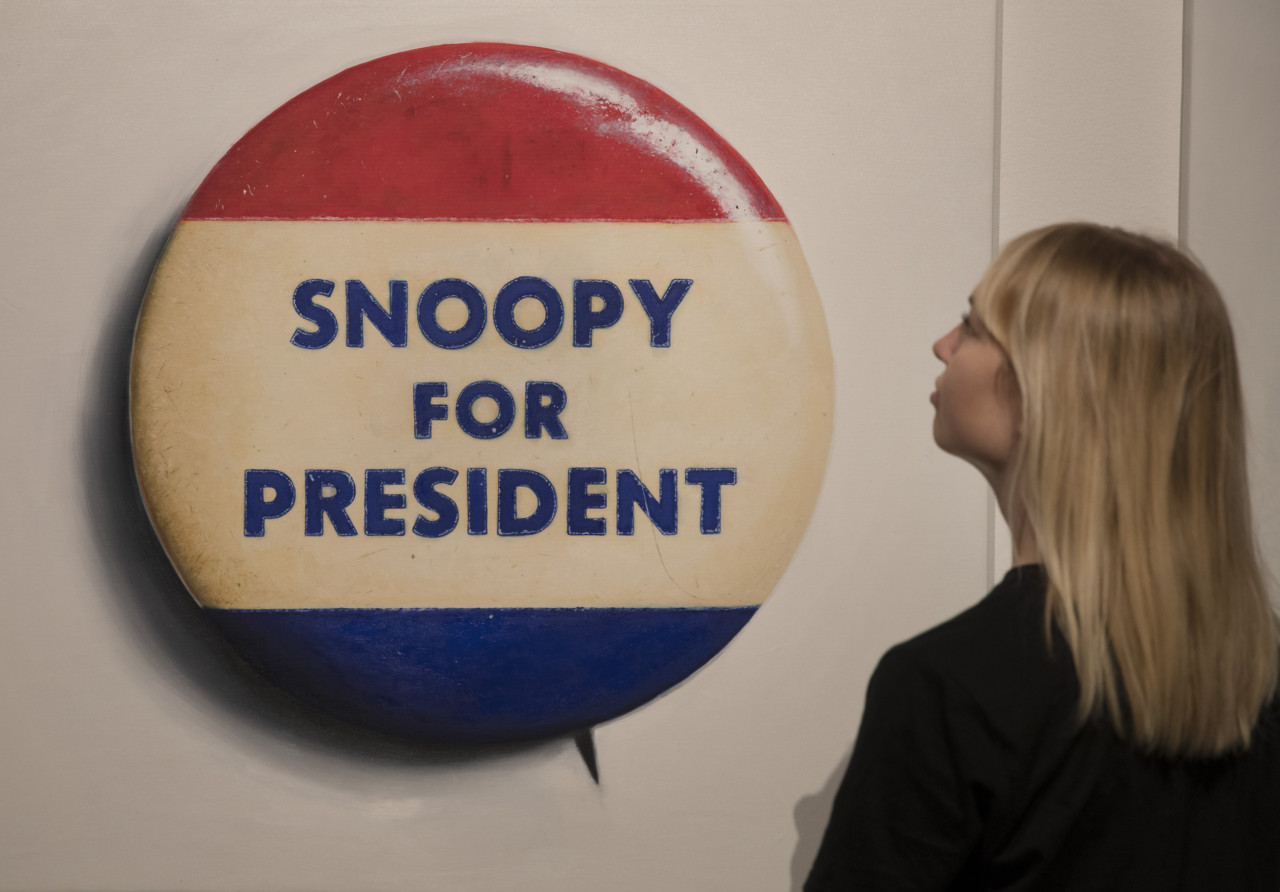


GOOD GRIEF, CHARLIE BROWN! at Somerset House. Photo credit: Peter Macdiarmid
Fiona Banner, Mel Brimfield, Mira Calix, Steven Claydon, Marcus Coates, François Curlet, Mark Drew, FriendsWithYou, Ryan Gander, Eloise Hawser, Andy Holden, Des Hughes, Ken Kagami, KAWS, Lauren LoPrete, Helen Marten, David Musgrave, patten, Matthew Plummer-Fernandez, Lucas Price and Ruth Proctor
The very first Peanuts cartoon strip appeared on 2 October 1950, syndicated to seven newspapers across the US. By 2000 when Charles M. Shultz died, he had drawn 17,897 separate Peanuts cartoon strips, with a readership of around 355 million in 75 countries. The statistics alone testify to the way that the cast of child characters and their laconic pet dog has entered popular consciousness. Schultz takes credit for coining the term “security blanket”, for example, with his character Linus and his ever-present blue blanket. Good Grief Charlie Brown! is a homage both to their creator and to the comic strips themselves. In the downstairs galleries there are original drawings, memorabilia and filmed interviews, while in the upper galleries work by more than 20 contemporary artists evidences the way the individual characters, as well as the moral, political and philosophical dimensions of the storylines are a rich source of material.
As the exhibition demonstrates with teenage drawings, Schulz was a talented draftsman from an early age, but his only formal art education had been a commercial correspondence course, taken in his last year in high school. The first part of the exhibition presents his leather catcher’s glove and charmingly old-fashioned ice skates as fetishistic tokens of an all-American life in a more innocent age. Other artefacts in the exhibition bear witness to an altogether more complex connection with turbulent periods in American history: there is a photograph of Captain Jim McDaniel, pictured in his helicopter in Chu Lai, Vietnam in July 1971 with Snoopy painted on his helmet; there is also an extraordinary 1970 letter from Ronald Reagan, then Governor of California, to Charles M. Schulz, concerning a particular strip he had read:
“Charlie was asking Lucy about what happens to a very nice baby waiting in heaven to be born when the mother and father decide they don’t want it. Lucy of course put him down severely. Charlie finished simply remarking he still thought it was a good question.”
Reagan goes on to describe his struggle with his personal faith and conscience when considering liberalising abortion laws, “Well, I didn’t mean to let you in on all my problems,” he finishes “but just to give the background of why you touched a nerve with your strip the other day. Thanks very much.”
Claire Caterall, curator of the exhibition and Senior Curator at Somerset House, has assembled work referencing the cartoon strip spanning two decades. David Musgrave’s Animal, 1998 presents an anatomical cross-section of Snoopy, suggesting a transcendence of the fictional into real life; Ryan Gander is present with a number of works, among them Linus Van Pelt and a world of Endeavour, Ambition and Optimism, 2008, which includes a pale blue blanket and paper lunch bag, as well as a graphic panel made up of the various, anguished mouth-shapes of the character. Through his child characters, Schulz communicated vulnerability and powerlessness in a way that connects with our essential humanity at any age in life.
For Steven Claydon, the character Pigpen – perpetually engulfed in an orbiting cloud of detritus and flies – is a useful “metaphor for the cultural associations that mass around objects.” Pigpen appears on the bronze bell in Untitled (Trom Bell), 2011, as part of a group of works that reference Louis Ferdinand Céline’s 1944 novel Guignol’s Band, in which he considers the regeneration of London after the destruction of the Blitz – “together from fragments, strands and particles a climate of narrative possibilities is formed”. Andy Holden’s installation Pessimism of the Intellect, Optimism of the Will, 2008-2011 consists of a group of painted bowls formed from melted 78rpm records of sentimental love songs from the 1950s, all incorporating Charlie Brown as a motif. Collaged with images cut from Peanuts cartoon strips, the work takes obsolete objects and gives them new function. The title of the work that so neatly pinpoints the world view of Charlie Brown is taken from the Italian Marxist philosopher Antonio Gramsci.
The interminable Sunday afternoons of my childhood would regularly find me lying on my stomach on the carpet of my parent’s living room, poring over the latest Peanuts cartoon in The Observer newspaper. Like millions of others, these weekly micro-narratives were probably the place I first understood about interior monologue, identified with self-doubt, glimpsed existentialist ideas and wished I had a friend as cool as Peppermint Patty. While unashamedly nostalgic in places, the exhibition is also a deep-dive into the influence of one man’s liberal minded, quirky and psychologically penetrating vision of 20th century life.
Caroline Douglas
Director
Somerset House, Embankment Galleries, South Wing,Strand, London WC2R 1LA. Open Monday, Tuesday, Saturday & Sundays 10.00-18.00; Wednesdays, Thursdays & Fridays 11.00-20.00. Exhibition continues until 3 March 2019. www.somersethouse.org.uk